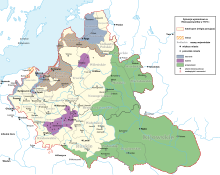Counter-Reformation in Poland
You can help expand this article with text translated from the corresponding article in Polish. (May 2018) Click [show] for important translation instructions.
|
The Counter-reformation in Poland (
History


Poland emerged as one of the main terrains of struggle between the
Soon after the words of Reformation reached Poland in the first half of the 16th century, Catholic authorities such as
At first the agents of counter-reformation in Poland focused on persuasion,
Nonetheless, compared to many other European countries, the conflict between the Catholics and the Protestants was relatively peaceful.
Many scholars agree that "Poland was one of the great successes of the Counter-Reformation"[23] and cite Counter-Reformation in Poland as the main instance where the Roman Catholic Church successfully reversed gains of the Reformation.[24] Others, however, such as Norman Davies, suggest that the triumph of the Counter-Reformation might have been exaggerated, and that at the very least not all Protestants were reconverted, nor was this the case with other denominations such as Eastern Orthodox.[24]
Counter-reformation ended with the
Reasons for success
Success of the counter-reformation in Poland can be attributed to the vigorous activities of the Jesuits and other monastical orders,
Significance
Catholicism was able to become a part of Polish identity and
Critics of the Counter-Reformation argue that it had contributed to the Commonwealth's decline, by reducing its cultural pluralism, tolerance, and receptiveness to foreign ideas, and by bringing about a stagnation in the intellectual life.[16]
See also
- Tumult of Thorn (Toruń)
- Franco de Franco, nearly executed for Protestantism
References
- ^ ISBN 978-0-313-03456-5.
- ISBN 978-1-00-128802-4.
- ^ ISBN 978-1-00-128802-4.
- ISBN 978-1-00-128802-4.
- ^ ISBN 978-0-7546-6825-1.
- ISBN 978-1-00-128802-4.
- ^ ISBN 978-1-00-128802-4.
- ^ ISBN 978-0-19-820171-7.
- ISBN 978-1-00-128802-4.
- ISBN 978-1-00-128802-4.
- ISBN 978-1-00-128802-4.
- ^ ISBN 978-1-00-128802-4.
- ^ ISBN 978-0-295-98093-5.
- ISBN 978-1-00-128802-4.
- ISBN 978-1-00-128802-4.
- ^ ISBN 978-1-134-71984-6.
- ISBN 978-1-4094-8247-5.
- ISBN 978-1-00-128802-4.
- ISBN 978-0-521-04545-2.
- ISBN 978-1-4426-1021-7.
- ISBN 978-0-7546-6825-1.
- ISBN 978-0-7864-2208-1.
- ISBN 978-1-137-38421-8.
- ^ ISBN 978-1-139-44881-9.
- ISBN 978-1-00-128802-4.
- ISBN 978-1-00-128802-4.
- ISBN 978-1-4094-0595-5.
- ^ ISBN 978-1-00-128802-4.
- ISBN 978-1-139-44881-9.
- ISBN 978-1-4094-8247-5.
- ISBN 978-0-7546-6825-1.
Further reading
- Oskar Halecki; W: F. Reddaway; J. H. Penson. The Cambridge History of Poland. CUP Archive. pp. 392–. ISBN 978-1-00-128802-4.
